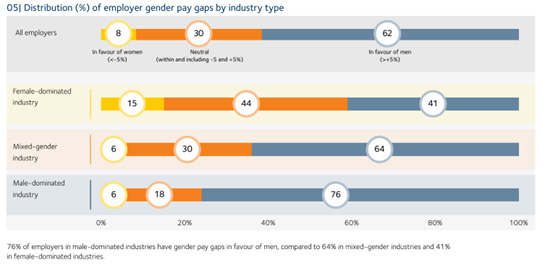Mind the Gap: Strategies to Overcome the Gender Pay Gap
06/03/2024
Melita Long Director of Careers on Purpose, is a Career Coach in Melbourne with 20 years’ experience advising mid-career professionals on career change and career progression. She is on the CDAA Victorian Committee and previously worked as a Career Consultant with MBA students at Melbourne Business School.

The Gender Pay Gap in Australia
The Gender Pay Gap (GPG) in Australia has only shifted marginally in 20 years. The current total remuneration GPG is 19%, and on average women earn $18,461 p.a. less than men. On base salary the GPG is 14.5% (average $11,542 less). Every industry has a median GPG in favour of men from Construction’s GPG at 31.8% and Accommodation and Food Services Industry at 1.9%. A summary of the worst GPG employers is in an AFR article.
Mandatory Gender Pay Gap Reporting
There is finally progress at a national level with the Workplace Gender Equality Amendment (Closing the Gender Pay Gap) Bill 2023. This requires mandatory reporting of GPG in 6 Gender Equality Indicators by private sector organisations with 100+ staff to the Workforce for Gender Equality Australia (WGEA), published on their website. Public Sector employers will need to do this in 2025. The first results from 4,987 employers published by the WGEA on February 27, 2024 show:
- 30% of employers have a median gender pay gap between the target range of +/- 5%.
- 62% of employers (3,057) have GPGs and in favour of men by over 5%.
- The rest (8%) are less than -5% and in favour of women.
- Across all employers, 50% have a GPG of >9.1%, as shown in the WGEA graphic:

In-depth information is on the WGEA website, their Employer Gender Pay Gaps Snapshot, and their Gender Pay Gap Analysis Guide and interactive company data. I encourage all career practitioners, People & Culture, Diversity & Inclusion, HR professionals, and business leaders to utilise game-changing data.
Individual GPG Strategies
How do career professionals help our female clients to earn what they are worth? There are proactive things career practitioners, and women can do to maximise career opportunities, show value, increase confidence, negotiate salary, and payrises, to earn what they are worth and help close the GPG:
Let’s focus on strategies and tactics that women, and the career practitioners supporting them, can undertake in their careers, to reduce the personal GPG, looking at mindset, current role and job hunting.
Mindset:
The key enabler for women to secure better careers, pay and conditions and help reduce the impact of GPG. When I asked successful senior women how they thought women can let themselves down in their careers, half related to mindset: 79% - lack of confidence, 71% - needing to meet 90% of a role before applying, 50% - doubting their ability to do a job. Some ways career practitioners can support women:
- Belief – Empower your female clients to believe in themselves, their worth, value they provide employers, and their ability to be successful. Explore women’s beliefs about themselves, their career, value and provide mindset coaching to help uncover the reasons and generate solutions. Before we can make change, we need to believe that it is possible.
- Confidence – Many women (and men) struggle with confidence in their career, which leads to doubts and insecurities. This is common if someone had an unsupportive, or abusive manager or partner. An excellent book that explores the many factors influencing confidence in women is “The Confidence Code”. Boost confidence by keeping track of positive feedback and thank you emails clients receive and use to help women write their CVs/resumes, identify, and quantify their achievements and monetary value provided in their roles.
- Ownership – Given women spend ~50 years working, take time out for caring, and live longer it is vital we take ownership of our own careers and our super. There is no loyalty from employers, so women need to be loyal to themselves, put their own oxygen mask on first and take charge. Help clients create a career plan to proactively prepare for opportunities to progress.
- Courage – One negative consequence of not believing in themselves, low confidence and lack of ownership is that women doubt themselves and often stay in unsatisfactory roles longer than necessary. Don’t put up with an employer that isn’t treating you with respect, paying you fairly, or in line your male colleagues. It takes courage to step outside your comfort zone, get into a better job, and support from career practitioners can be a key enabler for women.
Current Role
There are many ways to help women clients improve their current employment and reduce the GPG:
- Audit – Knowledge is power, your client needs to know where they stand, GPG in their organisation and how their salary compares. Help your female clients identify the following:
- GPG for your industry and your organisation using WGEA data. If your organisation hasn’t reported it, ask HR what the GPG is, and petition senior leaders to act.
- Your organisation’s Gender Equality Strategy – if not push for them to create one.
- Research market salaries using SEEK salary comparison, Michael page tool, and Payscale.
- Advocate – Help your client help themselves by not accepting status quo and proactively ask in:
- Performance Reviews – The best times to ask for payrises, promotions and discuss career progression. Help your client prepare examples of how they have added value with achievement stories and cost savings, or revenue generated.
- Payrises – Encourage clients to ask for a payrise every year, to help them prepare:
- Details of achievements and how they added value to the company since the last payrise - quantify time saved, financial benefits through money brought in or saved. Check out CDAA member Sue Ellson’s pay rise request guide.
- What they are worth based on market rates and in line with CPI increases.
- Mindset coaching to overcome fears and role play the conversation beforehand.
- Promotions – Encourage your client to identify opportunities for promotions, show their intentions to their manager and talk about career progression. Have facts ready, showing demonstrated value, ability to take on additional responsibilities and leadership capability.
- Leadership – One factor with Australia’s GPG is not enough women in leadership and Board roles. While some women don’t want this, we do need more female leaders. Coach and encourage female clients to believe they can become leaders and help them identify leadership pathways including leadership training, women on Boards, and mentoring - SheMentors and Mentor Walks.
- Planning – Help your client create a strategic career plan, identify pathways and careers in their current organisation, with steppingstones, training and networking for plan A and B. Encourage clients to information interview senior people whose roles they aspire to, often easier in larger organisations, which can have more support for women.
- Support – Key enablers for success are mentors and sponsors, senior leaders who encourage and support their career and create opportunities. Encourage female clients to actively seek support from mentors in their professional association and find sponsors in their organisation by reaching out to leaders. If the organisation is small and flat, if you can’t move up, then move out.
Job-Hunting
The best way to increase your salary is changing jobs, using some of the following approaches:
- WGEA – Choose WGEA employers of choice that actively support women and gender equality. You can also use the Data Explorer to explore industries and employers that are taking action.
- Courage - Encourage women not to wait until they meet 90% of a role before applying, often connected with perfectionism, which can be very counterproductive. Encourage women to go for a role they meet at least 70% of requirements and give themselves room to grow.
- Resumé –Help clients ensure their resume shows their value upfront with well quantified achievements proving how they save employers money or increase revenue. If you can show your employer that you can save many times your annual salary, it increases your marketability.
- Network – Get clients to proactively connect with senior leaders in their ideal role and in their industry on LinkedIn. Connect with people 2 levels above their current role, to reduce potential conflict and focus on asking for advice, rather than a job initially.
- Negotiate – The best chance to increase your salary is when you are offered a new job. HR Managers told me men almost always negotiate salary and women almost never do. “If you don’t ask, you don’t get”. Many women fear if they ask for more money the offer will be retracted, this is untrue. Read CDAA member Kelly Magowan’s book on salary negotiations, help clients to roleplay, back up their requests with market salary data and how they add value. It’s so empowering.
These are some of the ways we can help our female clients to reduce their GPG and improve their careers.